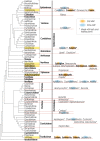Evolutionary histories and mycorrhizal associations of mycoheterotrophic plants dependent on saprotrophic fungi
- PMID: 33417080
- PMCID: PMC7817554
- DOI: 10.1007/s10265-020-01244-6
Evolutionary histories and mycorrhizal associations of mycoheterotrophic plants dependent on saprotrophic fungi
Abstract
Mycoheterotrophic plants (MHPs) are leafless, achlorophyllous, and completely dependent on mycorrhizal fungi for their carbon supply. Mycorrhizal symbiosis is a mutualistic association with fungi that is undertaken by the majority of land plants, but mycoheterotrophy represents a breakdown of this mutualism in that plants parasitize fungi. Most MHPs are associated with fungi that are mycorrhizal with autotrophic plants, such as arbuscular mycorrhizal (AM) or ectomycorrhizal (ECM) fungi. Although these MHPs gain carbon via the common mycorrhizal network that links the surrounding autotrophic plants, some mycoheterotrophic lineages are associated with saprotrophic (SAP) fungi, which are free-living and decompose leaf litter and wood materials. Such MHPs are dependent on the forest carbon cycle, which involves the decomposition of wood debris and leaf litter, and have a unique biology and evolutionary history. MHPs associated with SAP fungi (SAP-MHPs) have to date been found only in the Orchidaceae and likely evolved independently at least nine times within that family. Phylogenetically divergent SAP Basidiomycota, mostly Agaricales but also Hymenochaetales, Polyporales, and others, are involved in mycoheterotrophy. The fungal specificity of SAP-MHPs varies from a highly specific association with a single fungal species to a broad range of interactions with multiple fungal orders. Establishment of symbiotic culture systems is indispensable for understanding the mechanisms underlying plant-fungus interactions and the conservation of MHPs. Symbiotic culture systems have been established for many SAP-MHP species as a pure culture of free-living SAP fungi is easier than that of biotrophic AM or ECM fungi. Culturable SAP-MHPs are useful research materials and will contribute to the advancement of plant science.
Keywords: In vitro culture; Litter decay fungi; Orchid; Stable isotopes; Wood decay fungi.
Figures


Similar articles
-
Molecular evidence supports simultaneous association of the achlorophyllous orchid Chamaegastrodia inverta with ectomycorrhizal Ceratobasidiaceae and Russulaceae.BMC Microbiol. 2020 Aug 3;20(1):236. doi: 10.1186/s12866-020-01906-4. BMC Microbiol. 2020. PMID: 32746782 Free PMC article.
-
Mycoheterotrophic plants preferentially target arbuscular mycorrhizal fungi that are highly connected to autotrophic plants.New Phytol. 2022 Sep;235(5):2034-2045. doi: 10.1111/nph.18310. Epub 2022 Jul 7. New Phytol. 2022. PMID: 35706373 Free PMC article.
-
Some mycoheterotrophic orchids depend on carbon from dead wood: novel evidence from a radiocarbon approach.New Phytol. 2020 Sep;227(5):1519-1529. doi: 10.1111/nph.16409. Epub 2020 Feb 3. New Phytol. 2020. PMID: 31985062
-
Saprotrophic fungal mycorrhizal symbionts in achlorophyllous orchids: finding treasures among the 'molecular scraps'?Plant Signal Behav. 2010 Apr;5(4):349-53. doi: 10.4161/psb.5.4.10791. Epub 2010 Apr 25. Plant Signal Behav. 2010. PMID: 20061806 Free PMC article. Review.
-
The Waiting Room Hypothesis revisited by orchids: were orchid mycorrhizal fungi recruited among root endophytes?Ann Bot. 2022 Feb 11;129(3):259-270. doi: 10.1093/aob/mcab134. Ann Bot. 2022. PMID: 34718377 Free PMC article. Review.
Cited by
-
Spatiotemporal dynamics and functional characteristics of the composition of the main fungal taxa in the root microhabitat of Calanthe sieboldii (Orchidaceae).BMC Plant Biol. 2022 Dec 2;22(1):556. doi: 10.1186/s12870-022-03940-y. BMC Plant Biol. 2022. PMID: 36456905 Free PMC article.
-
Diverse Mycena Fungi and Their Potential for Gastrodia elata Germination.J Microbiol Biotechnol. 2024 Jun 28;34(6):1249-1259. doi: 10.4014/jmb.2401.01009. Epub 2024 Apr 29. J Microbiol Biotechnol. 2024. PMID: 38938004 Free PMC article.
-
Fungal association and root morphology shift stepwise during ontogenesis of orchid Cremastra appendiculata towards autotrophic nutrition.AoB Plants. 2022 May 9;14(3):plac021. doi: 10.1093/aobpla/plac021. eCollection 2022 Jun. AoB Plants. 2022. PMID: 35673361 Free PMC article.
-
Drastic mycorrhizal community shifts in Sceptridium ferns during the generation transition from fully mycoheterotrophic gametophytes to photosynthetic sporophytes.New Phytol. 2025 Feb;245(4):1705-1717. doi: 10.1111/nph.20330. Epub 2024 Dec 7. New Phytol. 2025. PMID: 39645585 Free PMC article.
-
Symbiont switching and trophic mode shifts in Orchidaceae.New Phytol. 2021 Jul;231(2):791-800. doi: 10.1111/nph.17414. Epub 2021 Jun 1. New Phytol. 2021. PMID: 33932029 Free PMC article.
References
-
- Abadie JC, Püttsepp Ü, Gebauer G, et al. Cephalanthera longifolia (Neottieae, Orchidaceae) is mixotrophic: a comparative study between green and nonphotosynthetic individuals. Can J Bot. 2006;84:1462–1477. doi: 10.1139/B06-101. - DOI
-
- Berg B, McClaugherty C. Plant litter: decomposition, humus formation, carbon sequestration. Berlin: Springer; 2008.
MeSH terms
Substances
LinkOut - more resources
Full Text Sources
Other Literature Sources
Miscellaneous

